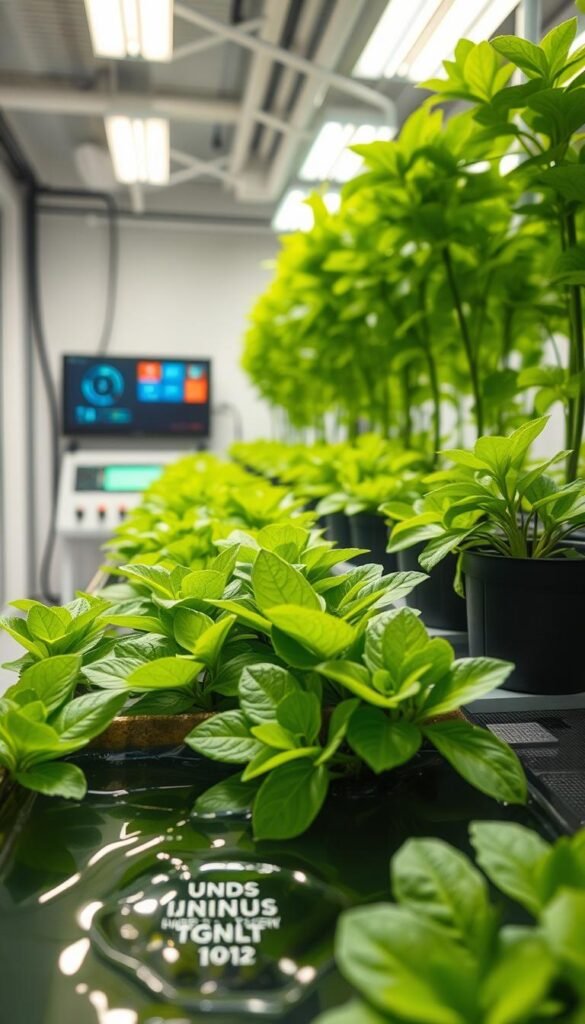Imagine growing lush, vibrant plants without traditional soil – that’s the power of modern gardening methods. These setups deliver precise mineral blends through water, letting roots absorb exactly what they need for optimal growth. Brands like Canna have perfected formulas that mimic nature while conserving resources.
Traditional fertilizers often lack the balance needed for delicate root systems. Natural options provide stable nutrition while using 90% less water than conventional methods. This approach helps prevent common issues like pH swings that can stall your garden’s progress.
What makes these solutions stand out? They combine:
– Plant-friendly mineral ratios
– Reduced environmental impact
– Faster growth rates (up to 50% quicker!)
You’ll discover how to maintain thriving systems through proper monitoring and eco-conscious choices. We’ll compare different sustainable options and share pro tips for avoiding nutrient lockout. Whether you’re new to soil-free gardening or optimizing an existing setup, this guide helps create greener spaces that flourish.
Understanding Organic Nutrient Alternatives in Hydroponic Systems
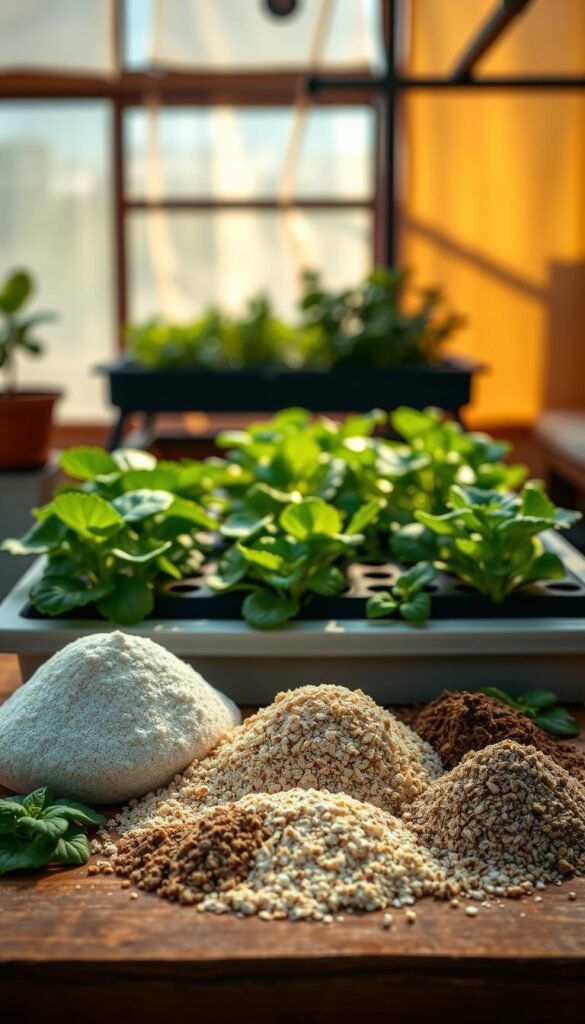
Let’s explore how natural plant foods work in water-growing setups. Unlike synthetic options, these solutions come from decomposed materials like seaweed or worm castings. Tiny microbes break them down into usable forms through mineralization – nature’s recycling program!
What Makes Water-Grown Plant Food Different?
Traditional soil feeding relies on slow nutrient release through dirt. Water-based systems deliver food directly to roots through liquid solutions. This method:
- Uses 80% less water than dirt farming
- Prevents waste from runoff
- Allows precise control of mineral levels
Keeping Your Liquid Food Balanced
Successful gardens need regular checks. Test your solution’s pH (5.5-6.5 ideal) and electrical conductivity daily. Plants need different mineral mixes as they grow:
- Seedlings: More nitrogen for leaves
- Flowering: Extra phosphorus for blooms
- Fruiting: Potassium boost for yield
Try compost tea or fish emulsion for sustainable options. These natural sources improve flavor while reducing chemical use. Remember – healthy microbes mean happy plants!
Organic Nutrient Alternatives for Eco-Friendly Hydroponics
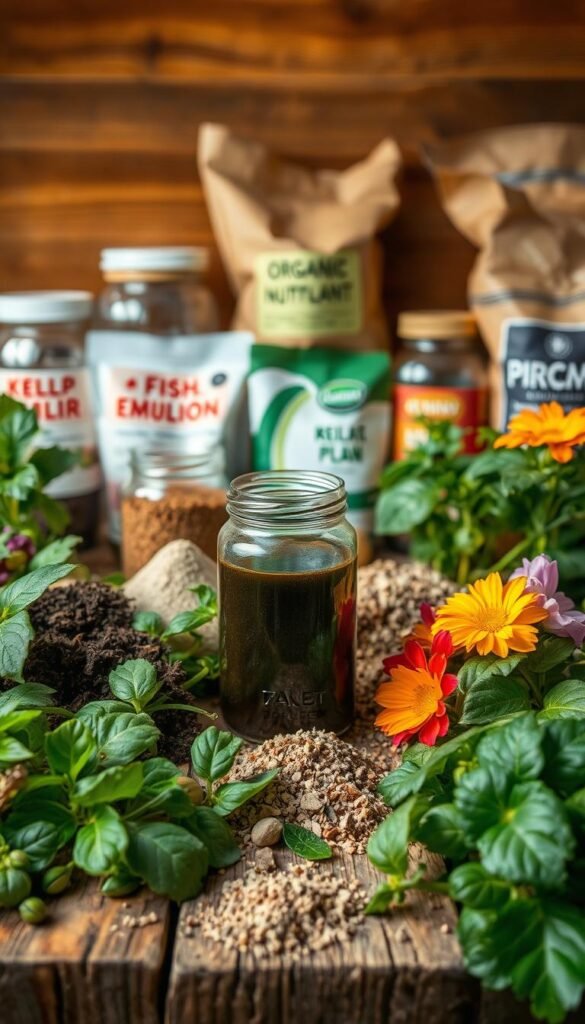
Discover how earth-derived solutions boost growth in liquid setups. These natural formulas work differently than lab-made options, feeding roots through microbial activity rather than direct absorption. Brands like General Hydroponics offer blends that balance minerals while keeping ecosystems healthy.
| Feature | Earth-Based | Lab-Created |
|---|---|---|
| Source | Compost, seaweed | Chemical salts |
| pH Stability | Self-buffering | Needs adjustment |
| Microbe Support | Promotes colonies | Sterile |
| Environmental Impact | Low runoff risk | High salt buildup |
Your plants need three key elements most:
- Nitrogen – From fish emulsion for leaf development
- Phosphorus – Found in bone meal for root strength
- Potassium – Provided by kelp for fruit production
Botanicare’s Pure Blend Pro shows how these components work together. Their formulas maintain stable pH levels while delivering 18 trace minerals. Mix solutions weekly using measuring cups – irregular dosing causes imbalances.
Common issues? Cloudy reservoirs usually mean bacterial bloom, not failure. Add air stones to boost oxygen. Dark roots signal healthy microbial activity, not rot. With proper care, these systems grow crops 30% faster than traditional methods!
Choosing the Right Organic Nutrients for Your Hydroponic Garden
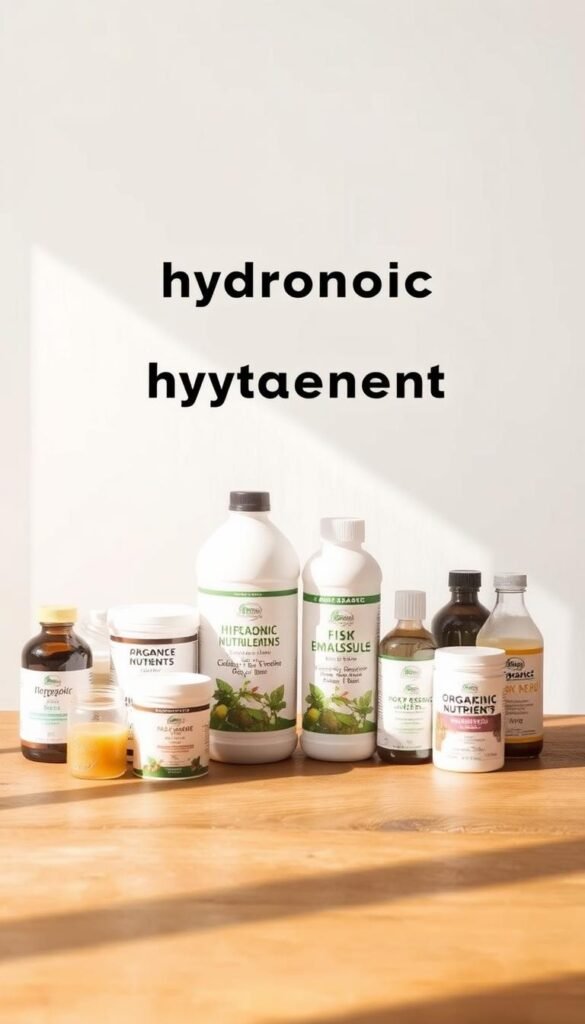
Ever wondered how to pick the perfect plant food for your water-based setup? Start by understanding labels like a pro. Most natural fertilizers list three numbers representing nitrogen (N), phosphorus (P), and potassium (K). For leafy greens, aim for higher first numbers like 3-1-2. Fruiting varieties thrive with balanced ratios like 2-2-2.
Evaluating Nutrient Composition
Top brands like FoxFarm and Gaia Green provide detailed mineral breakdowns. Look beyond N-P-K values – trace elements like calcium and magnesium matter too. A 2023 University of Florida study showed crops grown with complete formulas yielded 22% more than basic mixes.
| Product | N-P-K Ratio | Trace Elements | Best For |
|---|---|---|---|
| Neptune’s Harvest | 2-3-1 | Iron, Zinc | Leafy Greens |
| Down to Earth | 4-6-2 | Calcium, Sulfur | Tomatoes |
Tailoring Nutrients to Specific Plant Needs
Your lettuce craves different minerals than your strawberries. Young seedlings need nitrogen-heavy blends, while flowering plants demand phosphorus boosts. Keep a growth journal – if leaves yellow after week three, increase iron levels.
Pro tip: Test your solution weekly with pH strips. Most vegetables prefer 5.8-6.3 ranges. Adjust mixtures gradually – sudden changes shock roots. With the right balance, you’ll see thicker stems and brighter blooms in 10-14 days!
Designing a Sustainable Hydroponic System
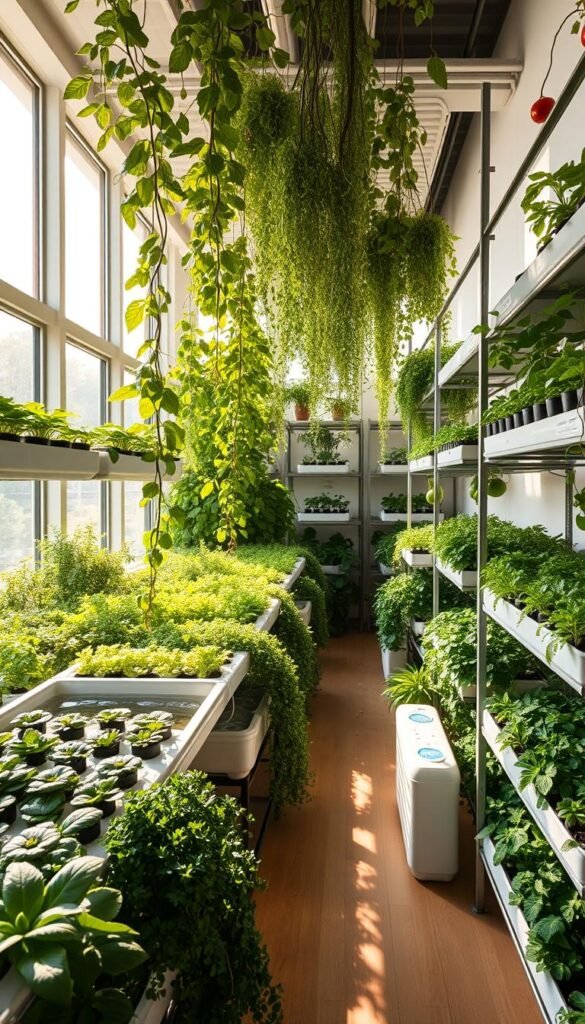
Want a garden that saves resources while thriving? Smart design turns your setup into an efficient powerhouse. Start by choosing energy-smart tools and water-wise methods that keep plants happy without waste.
Energy and Water Efficiency Strategies
Swap old bulbs for full-spectrum LEDs. Brands like Philips GreenPower cut energy use by 40% while boosting leaf production. Pair lights with timers to mimic natural daylight cycles—your greens won’t know the difference!
Water management matters most. Closed-loop systems reuse 95% of liquid by filtering through gravel beds or coconut coir. Add a small pump to recirculate your mix daily. This approach slashes monthly water use to just 10 gallons for a 4×4 ft setup.
| Strategy | Tool | Savings |
|---|---|---|
| Lighting | LED Grow Panels | 50% less energy |
| Water Flow | HydroLogic Filters | 90% reuse rate |
| Nutrient Delivery | Drip Irrigation | 25% faster growth |
Track performance with simple tools. A $15 TDS meter checks nutrient solution strength, while pH strips prevent imbalances. For inspiration, explore budget-friendly DIY setups that use recycled materials.
Weekly checks keep everything on track. Adjust lighting height as plants grow taller. Flush pipes monthly to avoid salt buildup. With these tweaks, you’ll see fuller leaves and juicier fruits in half the time!
Mixing and Applying Organic Nutrient Solutions
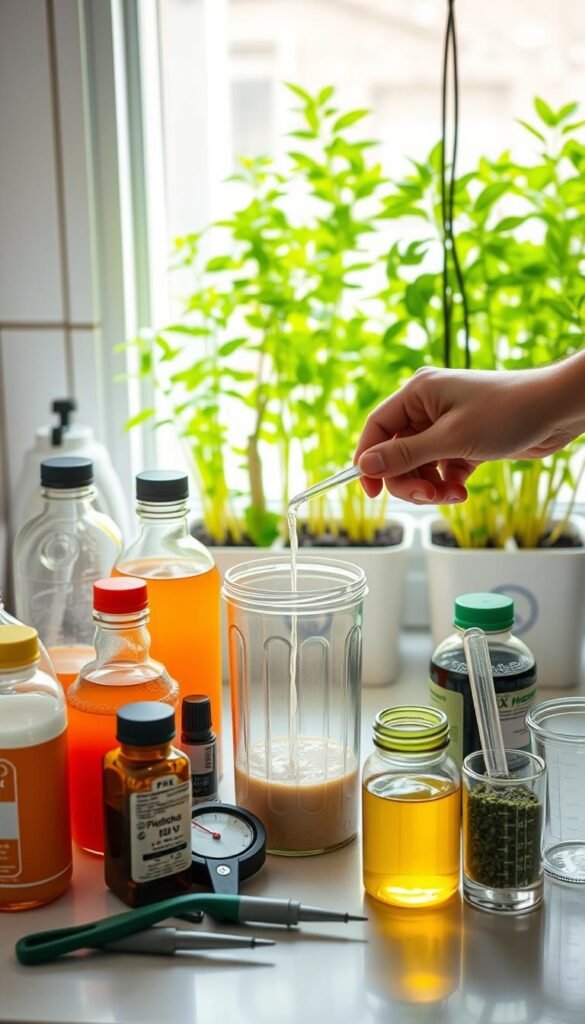
Creating perfect plant food blends starts with precision. Proper preparation ensures your greens get exactly what they need without waste or harm. Let’s break down the process into simple, repeatable steps.
Step-by-Step Mixing Guide
Gather clean containers and measuring tools first. Follow this sequence for best results:
- Fill your reservoir with water (room temperature)
- Add base minerals first – calcium then magnesium
- Stir gently while pouring in liquid concentrates
- Wait 15 minutes between additives
Always check electrical conductivity (EC) after each addition. Target 1.2-2.4 mS/cm for most crops. A digital meter eliminates guesswork – try the Bluelab Combo for instant readings.
Application Techniques for Optimal Growth
Different setups demand unique approaches. Deep water culture needs daily circulation, while drip systems thrive with timed feeds. Consider these methods:
| System Type | Frequency | Duration |
|---|---|---|
| NFT | Continuous | 24/7 |
| Ebb & Flow | Every 2 hours | 15 minutes |
| Aeroponics | Every 30 mins | 3 minutes |
Rotate reservoir contents weekly to prevent settling. Experienced growers like Epic Gardening recommend adding beneficial bacteria during mixing. This boosts root health and fights pathogens naturally.
Pro tip: Test pH after mixing and before feeding. Small adjustments (0.5 increments) prevent shock. With practice, you’ll develop an eye for ideal solution clarity – slightly amber means perfect balance!
Monitoring and Adjusting Nutrient Levels
Keeping your garden thriving requires regular check-ups, just like your favorite houseplant. Precise tracking prevents problems before they impact growth. Think of it as giving your greens a daily vitamin boost tailored to their exact needs.
Mastering Measurement Tools
Start each morning with a quick meter check. Dip your pH tester into the reservoir first – aim for 5.8-6.3 for most crops. Bluelab’s Guardian Connect shows real-time data through smartphone alerts, making tracking effortless.
Follow this 3-step process:
- Test electrical conductivity (EC) to gauge mineral strength
- Adjust pH using citric acid (lower) or baking soda (raise)
- Record readings in a growth journal
Yellow leaves? That’s often iron deficiency. Brown tips usually signal salt buildup. Catch issues early by comparing current readings to last week’s numbers. Small tweaks prevent big headaches!
| Problem | EC Range | Fix |
|---|---|---|
| Slow Growth | Below 1.0 | Increase minerals by 25% |
| Leaf Curl | Above 3.0 | Dilute solution with water |
Consistency matters most. Check levels at the same time daily – morning readings stay most stable. Pair meter data with visual plant checks. Brighter colors and firm stems mean your adjustments work!
Benefits of Organic Nutrient Alternatives
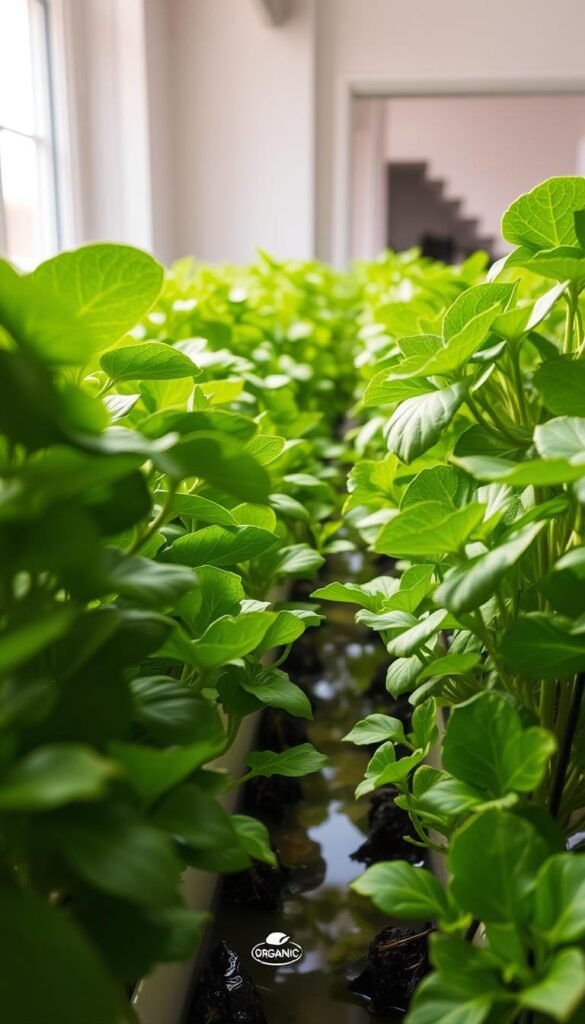
Ready to see your garden thrive while keeping costs low? Natural plant food options create healthier crops and happier ecosystems. These solutions deliver measurable improvements in both plant health and environmental impact compared to traditional methods.
Stronger Crops, Bigger Harvests
Growers report 20-35% larger yields when switching to natural formulas. A 2023 Cornell study showed basil plants produced 28% more leaves with earth-based food. Three key advantages stand out:
- Reduced leaf discoloration from balanced mineral ratios
- Denser root networks that absorb 40% more nourishment
- Enhanced flavor profiles in herbs and vegetables
Tomato growers using fish-based solutions saw 90% less blossom-end rot. The secret? Steady calcium release from natural sources prevents sudden mineral drops.
Savings That Grow Over Time
Earth-friendly practices benefit both wallets and waterways. Compare these annual costs for a 10-gallon setup:
| Expense | Synthetic | Natural |
|---|---|---|
| Plant Food | $120 | $85 |
| pH Adjusters | $45 | $12 |
| Water Replacement | Monthly | Quarterly |
Natural options require 60% fewer solution changes thanks to microbial balance. Local ecosystems benefit too – urban growers report 75% less algae in drainage systems.
By choosing plant-first solutions, you create gardens that actually taste like nature intended. Reduced maintenance means more time enjoying crisp lettuces and aromatic herbs. Your initial switch leads to lasting rewards – for your plate and the planet.
Integrating Sustainable Practices in Hydroponics

Building a greener future starts with smart choices in your indoor garden. Pair earth-conscious methods with modern tech to create setups that thrive while protecting ecosystems. Let’s explore three pillars that transform standard operations into climate-friendly powerhouses.
Guardians of Growth: Natural Pest Defense
Skip harsh sprays that harm beneficial microbes. Introduce ladybugs or lacewings to combat aphids naturally. Neem oil sprays (1 tbsp/gal) disrupt pest life cycles without affecting your plants. For fungus gnats, sprinkle cinnamon powder – it’s a natural fungicide that larvae hate!
Manage waste like a pro:
- Filter used nutrient solutions through charcoal for reuse
- Compost root balls with worm bins
- Repurpose plastic containers as seedling trays
Powering Progress With Clean Energy
Cut electricity bills while boosting efficiency. Solar panels from brands like SunPower can run pumps for 6 hours daily without grid power. Pair them with Tesla Powerwall batteries for night operations. See how different options stack up:
| Energy Source | Setup Cost | Annual Savings |
|---|---|---|
| Solar | $1,200 | $180 |
| Wind | $2,500 | $310 |
| Hybrid | $3,000 | $450 |
A 2024 UC Davis study showed solar-powered systems reduced carbon footprints by 62%. Track performance with smart meters – they alert you when energy use spikes. Replace old pumps with ENERGY STAR models to save 30% on power.
Weekly checks keep everything balanced. Test water quality every Thursday and log results. Notice faster growth? That’s your system working smarter, not harder. Small changes create ripple effects – healthier crops, lower bills, and happier ecosystems!
Wrapping Up Your Sustainable Hydroponic Journey
Your path to greener gardening ends here – but your plants’ growth is just beginning. By choosing natural formulas, you’ve unlocked tastier harvests and sturdier crops while protecting local ecosystems. Remember: balanced nutrient solutions and smart monitoring create gardens that thrive year-round.
Start small. Mix formulas using precise measurements, test pH weekly, and track growth patterns. Pair these earth-friendly methods with solar-powered pumps or recycled water systems. One urban grower boosted yields by 40% using this combo – your results could shine brighter!
Keep experimenting. Try bone meal blends for root development or kelp extracts during flowering stages. Bookmark resources like macro micronutrient guides to refine your approach. Every adjustment brings you closer to self-sufficient growing.
Your efforts ripple beyond the garden. Healthier crops mean fewer synthetic chemicals in waterways. Efficient systems conserve resources for future generations. Now grab those gloves – your vibrant, sustainable oasis awaits!

